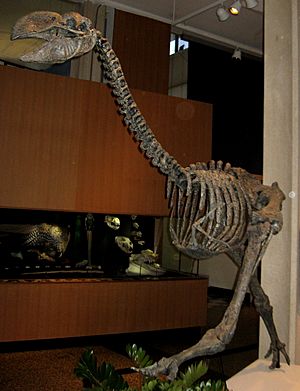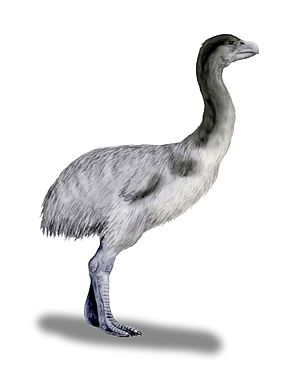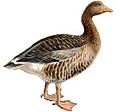Dromornithids facts for kids
Quick facts for kids Dromornithids |
|
|---|---|
 |
|
| Dromornis stirtoni | |
| Scientific classification |
|
| Kingdom: | Animalia |
| Phylum: | Chordata |
| Class: | Aves |
| Clade: | Anserimorphae |
| Order: | †Gastornithiformes |
| Family: | †Dromornithidae Fürbringer, 1888 |
| Genera | |
|
|
Dromornithidae, also known as mihirungs, thunder birds, or demon ducks, were a group of huge, flightless birds that lived in Australia. They roamed the land from about 25 million years ago (during the Oligocene Epoch) until about 30,000 years ago (during the Pleistocene Epoch). Sadly, all of them are now extinct.
These amazing birds were part of the Australian megafauna, which means they were among the very large animals that lived in Australia long ago. One species, Dromornis stirtoni, could grow up to 3 meters (10 feet) tall! The Australian megafauna disappeared between 50,000 and 20,000 years ago. Scientists are still debating why, but human hunting might have played a part.
For a long time, scientists thought mihirungs were related to modern ratites like emus and ostriches. But now, most experts believe they are more closely related to waterfowl (like ducks and geese). This is because of details found in their skulls.
Contents
About Mihirungs
Mihirungs looked a bit like giant emus or moa, which were also large, flightless birds. They had heavy bodies, very strong legs, and tiny wings that couldn't be used for flying. Their toe bones were shaped like small hooves instead of claws. Like other flightless birds, they didn't have a keel (a ridge) on their breastbone. This keel is usually where strong flight muscles attach in birds that can fly.
Mihirungs varied in size. The smallest, Barawertornis tedfordi, was about the size of a modern cassowary, weighing around 80 to 95 kg (176 to 209 lb). The largest, Dromornis stirtoni, could reach 3 meters (10 feet) tall. It might have been one of the biggest birds ever to live, after the elephant birds.
What Did Mihirungs Eat?
Scientists generally agree that dromornithids were plant-eaters, or herbivores. This idea comes from several clues:
- Their beaks didn't have a hook at the end, which is common in meat-eating birds.
- They didn't have sharp talons (claws) on their toes.
- They often had gizzard stones (small stones in their stomachs). These stones helped them grind up tough plant material. (Though some meat-eaters like crocodiles also have them!)
- Many individuals were found together, suggesting they lived in flocks, which is common for herbivores.
However, some species like Bullockornis planei had very large, deep beaks. This made some scientists wonder if they might have been carnivores (meat-eaters) or omnivores (eating both plants and meat). But most experts now believe that even Bullockornis was a herbivore. Its strong beak might have been used to crush very tough plants or even as a way to show off to other birds.
How Fast Could They Run?
Because of their huge size, people first thought mihirungs were slow and clumsy. Their legs weren't long and thin like those of fast-running birds such as emus or ostriches. However, studies of their leg muscles suggest they might have been able to run much faster than expected. They made up for their less-than-ideal leg shape with sheer strength!
Where Did Mihirungs Live?
Fossils of mihirungs have only been found in Australia. Most discoveries come from the eastern part of the continent, but some have also been found in Tasmania and Western Australia. In some places in the Northern Territory, their bones are very common, making up a large part of the fossils found.
The oldest mihirung bones found so far are from about 25 million years ago in Queensland. The most recent evidence, from Genyornis newtoni, was found in New South Wales and is about 31,000 years old.
Why Did Mihirungs Disappear?
The reasons why all mihirungs and the rest of the Australian megafauna died out are still being debated. This happened around the end of the Pleistocene Epoch.
One idea is that the first humans arrived in Australia around 48,000 to 60,000 years ago. Their hunting and their use of fire to change the landscape might have contributed to the animals' disappearance. Another idea is that very dry conditions during a period of peak glaciation (about 18,000 years ago) played a role.
Scientists are still discussing which factor was most important. It's likely that a mix of all these things led to the extinction of these giant birds.
How Were Mihirungs Discovered?
Aboriginal people definitely knew about Genyornis newtoni during the Late Pleistocene. There are cave paintings that might show this bird, and carved footprints that are larger than those of emus. At a site called Cuddie Springs, Genyornis bones have been found alongside human tools. This suggests that humans and these birds lived at the same time.
The first Europeans to find mihirung bones might have been Thomas Mitchell and his team. In 1872, the first species, Dromornis australis, was described by Richard Owen from a bone found in a well in Queensland.
Large collections of mihirung fossils were later found at Lake Callabonna in South Australia. In 1892, E. C. Stirling and A. H. C. Zietz from the South Australian Museum heard about large bones in a dry lake bed. Over several years, they collected almost complete skeletons of several birds. They named this new species Genyornis newtoni in 1896.
Other important fossil sites include Bullock Creek and Alcoota in the Northern Territory. Many bones from these sites were studied much later, in 1979, by Patricia Rich, who described five new species and four new groups of mihirungs.
The most common mihirung bones found are vertebrae (backbones), long leg bones, and toe bones. Ribs and wing bones are rare. The rarest part is the skull. For many years, only a damaged skull of Genyornis was known. This meant early drawings of mihirungs looked like giant emus.
However, scientists Peter Murray and Dirk Megirian found enough skull pieces of Bullockornis planei to get a good idea of what its head looked like. They discovered that Bullockornis had a very large skull, with an enormous beak making up about two-thirds of it. The beak was deep but narrow, with sharp edges at the front and crushing surfaces at the back. It had strong muscles, meaning Bullockornis had a powerful bite. Fragmentary skull remains of Dromornis also suggest it had an oversized skull.
Besides bones, other clues about mihirungs have been found:
- Gastroliths: These are polished stones found in the birds' gizzards (muscular stomachs). They helped the birds digest tough food.
- Trackways: Series of fossilized footprints have been found at several sites, showing how they walked.
- Endocasts: These are natural casts of the inside of the skull cavity. They form when sediment fills the empty skull, and then the skull decays away. These fossils give us a fairly accurate picture of what mihirung brains looked like.
Images for kids
-
Artist's reconstruction of Dromornis stirtoni.

See also
 In Spanish: Dromornítidos para niños
In Spanish: Dromornítidos para niños







